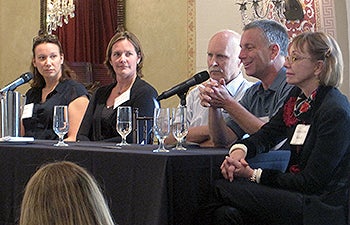The Environmental Story of L.A.
The Los Angeles area has long played host to a complex relationship between humans and nature. From early coastal populations 10,000 years ago to today’s massive Port of Los Angeles community, local residents have played a strong role in shaping the coastal environment in which we live.
That was the subject of a special symposium at USC on April 27 titled “Natural History of Los Angeles — Our Coastal Environment: Past, Present and Future,” held at Town and Gown on the University Park campus. The USC Wrigley Institute for Environmental Studies and the USC Sea Grant program, both part of USC Dornsife, jointly hosted the event with the Natural History Museum of Los Angeles County.
“The goal of the symposium was to bring together scientists and policy makers in a multidisciplinary format to share insights about the human and natural history of the L.A. region and to kindle new collaborations,” said Phyllis Grifman, associate director of the USC Sea Grant program.
Invited experts gave perspectives from a variety of different academic disciplines and public professions. Speakers included city officials, regional management organizations, biologists, geographers, architects and anthropologists. These viewpoints were combined to give a historical perspective on L.A.’s transformations from native coastal habitat to urban metropolis, and a basis from which to discuss present-day challenges and goals for the city’s sustainable environmental future.

Panelists discussing Los Angeles coastal habitats during the April 27 symposium included, from left: Juliette Hart, Christine Whitcraft, Richard Ambrose, Steve Weisberg and Geraldine Knatz. Photo by Phyllis Grifman.
Emphasis was also placed on understanding the human uses of landscapes and seascapes, and the connections between these two systems.
“Historically, the relationship between the land and the sea was driven exclusively by natural phenomena. Over time, humans have become part of this fabric, with positive and negative consequences,” said Wrigley Institute Director Roberta Marinelli. “It is important to recognize the connections between these places to gain an integrated understanding of how humans transform the Southern California coastline.”
A keynote perspective from anthropologist Jennifer Perry of California State University Channel Islands reminded the group that people have been using and modifying the Southern California environment for well over 10 centuries. A discussion of topics ranging from green infrastructure to watershed management and coastal monitoring plans followed, with speakers and panelists discussing a range of emerging initiatives for conserving LA’s habitats, resources, livelihoods and economies.
Matt Petersen, chief sustainability officer for the City of Los Angeles and the symposium’s featured lunch speaker, reinforced many of these priorities as he reviewed the sweeping citywide goals recently laid out by Mayor Garcetti in L.A.’s first sustainability plan.
The meeting also provided fuel for new research and policy collaborations across the region. Co-organizers Regina Wetzer and Dean Pentcheff with the Natural History Museum were encouraged by this important outcome.
“What we hoped to do was to bring together representatives who work on related issues on land and in the sea to learn from each other’s perspectives and to find collaborative opportunities, “ Pentcheff said. “From our experience, and from what we’ve heard from participants, that’s exactly what happened — we’re delighted with how it went!”